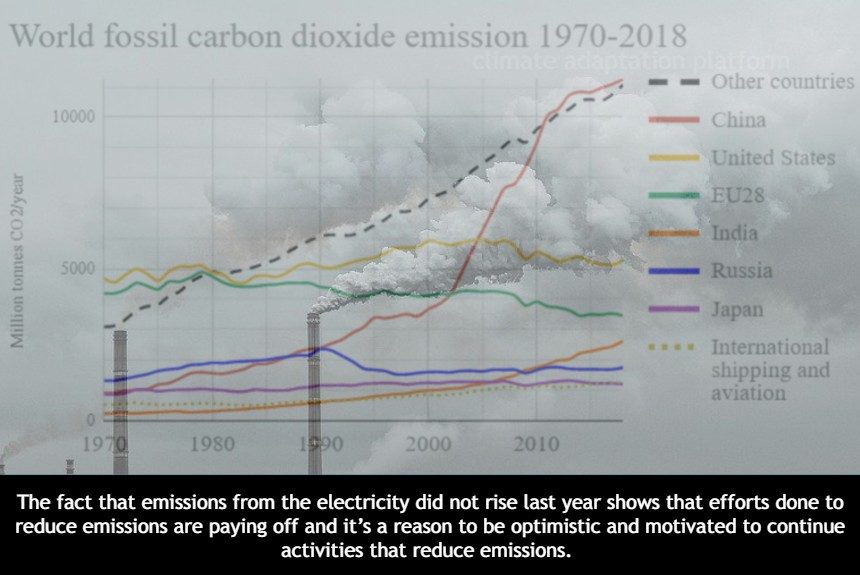The Economist reported on 24 February 2019 that industrial carbon emissions did not rise in 2019. This seems like an achievement, a break from the pessimistic climate change news we read daily.
The announcement of a plateau of emissions last year is tied to Amazon’s owner, Jeff Bezos, who is poised to invest US$10 billion in a philanthropic foundation aimed at fighting climate change, according to the article. Perhaps a ‘greenwashing’ effort to offset and balance out emissions from his giant retail company, the Economist article says.
What is the source of this good news?
According to Dr Fatih Birol, Executive Director of the International Energy Agency (IEA), global carbon dioxide emissions remained unchanged at 33 gigatons last year, while the economy grew by 2.9% (Global CO2, 2020).
This plateau results from declining emissions from electricity generation in developed countries as they switch to renewables like wind and solar, switch from coal to natural gas, and increase nuclear power generation (Defying Expectations, 2020).
Dr Birol says, “We need to work hard to make sure that 2019 is remembered as a definitive peak in global emissions, not just another pause in growth”.
This statement could be a warning in some sense because while advanced economies like the US, European Union, and Japan continue to see a reduction in emissions due to power-efficient technologies, a shift to renewables, and decreasing use of coal in electricity generation, developing economies in Asia are still highly dependent on coal (Storrow, 2020).
The United States recorded a decline in emissions of 140 million tonnes, or 2.9%. In comparison, the European Union’s emissions fell by 160 million tonnes, or 5%, following their switch to natural gas for electricity production, and Japan’s emissions decreased by 45 million tonnes, or 4%. Emission reductions by these developed countries, even if added together, still require a bit more to offset the 400 million tonnes emitted by the rest of the world, which represents an almost 80% increase from coal-fired power generation (Defying Expectations, 2020).
The International Energy Agency (IEA) also showed the global emissions trend for both advanced economies and the rest of the world in a graph; the regional trends showed a decline in emissions, their shift from coal to renewables in regions like the US, EU, Germany, UK, Japan, China and India; and the electricity generation and power section C02 emissions in advance economies.
Storrow (2020) pointed out that although there is an emissions reduction in the energy sector, CO2 and other gases are still emitted in other places, such as wildfires in the Amazon and Australia, the transportation sector, natural gas usage, and methane emissions or leaks.
How about emissions from the production of services?
Gernot Wagner of New York University noted that the global shift in production of supplies makes emissions from developed countries appear more favourable. Giant companies like Apple and Volvo have relocated their production plants to other parts of the world.
So, who takes responsibility for its emissions? Wagner thinks it’s down to the consumers. Because carbon emissions are global in scope, carbon emissions worldwide must reach net zero to reduce CO2 concentrations to sustainable levels (Storrow, 2020).
A reason for optimism
The fact that emissions from electricity did not rise last year shows that efforts to reduce emissions are paying off, and it’s a reason to be optimistic and motivated to continue activities that reduce emissions. As Dr Birol says, this welcome halt in emissions is grounds for optimism that we can tackle the climate challenge this decade. It is evidence that clean energy transitions are underway, and signal that we can meaningfully move the needle on emissions through more ambitious policies and investments” (Defying Expectations, 2020).
To support these objectives, the IEA will publish a Special Report in June that details how to cut global energy-based emissions by one-third and keep on track to meet long-term climate goals (Defying Expectations, 2020).
This development is a great encouragement for all, especially those engaged in climate change advocacy programs. Indeed, the worldwide effort made by governments, business establishments, and not-for-profit organisations to curb carbon emissions has shown positive results.
Sources:
Global CO2 emission in 2019. (2020 February 11). IEA. Retrieved from https://www.scientificamerican.com/article/global-co2-emissions-were-flat-in-2019-but-dont-cheer-yet/
Defying expectations of a rise, global carbon dioxide emissions flatline in 2019. (2020, February 11). IEA. Retrieved from https://www.iea.org/news/defying-expectations-of-a-rise-global-carbon-dioxide-emissions-flatlined-in-2019
Storrow, B. (2020, February 12). Global CO2 Emissions Were Flat in 2019 – But Don’t Cheer Yet. Scientific American. Retrieved from https://www.scientificamerican.com/article/global-co2-emissions-were-flat-in-2019-but-dont-cheer-yet/



Leave a Reply